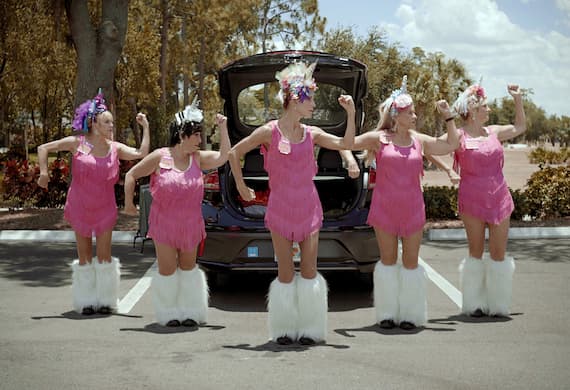
* * *
In Book IX of “The Republic,” Socrates, through the offices of his faithful amanuensis Plato, famously pondered the meaning and measure of a life well lived. The good life, we learn, should be dedicated to “contemplation, self-examination and open-minded wondering.” In further extolling its qualities and complications, Socrates mentions friendship and how it should be entered into cautiously, but “when thou are in, continue firm and constant.”
Socrates and his musings came repeatedly to mind while watching “Calendar Girls,” the debut documentary by Swedish filmmakers Love Martinsen and Maria Loohufvud. Although it may seem a stretch to liken a seminal tract of Western civilization with a cadre of self-described “old broads” prancing around in unicorn tiaras and fuzzy leggings, think again: The Calendar Girls, to a woman, are walking-and-talking embodiments of the good life or, anyway, among the many good lives to be had.
In 2018, Mr. Martinsen and Ms. Loohufvud were vacationing with their children at Cape Coral, Florida, when they caught sight of “a group of women all dressed in mini skirts and sequins.” After ascending the bed of a truck, this eye-catching phalanx began to dance. Noting that each woman was of a certain age, the filmmakers were diverted, delighted, and discomfited. “Why are we surprised,” they asked themselves, “to see a bunch of women in their 60s dance, flirt, and just have a lot of fun?”
Mr. Martinsen and Ms. Loohufvud subsequently contacted the leader of the Calendar Girls, Katharine Shortlidge, she of the deep-set eyes and towering frame. “We’re up for anything,” Ms. Shortlidge responded when the couple floated the idea for a film. With children and grandma in tow, the two Swedes made Florida their home away from home and set up shop to “to make an intimate and respectful portrait, not just another film about ‘crazy Floridians.’”
Will “Calendar Girls” dissuade audiences from thinking that Florida is, in fact, a haven for the peculiar? An informal poll of cinephiles found mixed responses to Mr. Martinsen and Ms. Loohufvud’s “life-affirming, feel-good documentary.” Ms. Magazine thought the film “disingenuous” because it failed to address a social justice agenda. Another observer castigated the picture for its valorization of kitsch. Then there was the purist who felt that the “girls” made a mockery of dance, noting that their choreography and its trappings diminished the artform.
Few people will mistake the Calendar Girls for the Rockettes, the Fly Girls, or the Bolshoi Ballet, though there are members of the troupe who move with an impressive snap and, for that matter, possess gams that would have been the envy of Betty Grable. But I daresay the ladies themselves would be the first to avow that community rather than High Art is at the top of the agenda. Each of the Calendar Girls is a volunteer, and the group does its performances for charity, chief among them an organization that provides guide dogs for veterans.
And they spread not a little joy, all the while maintaining a realism about their endeavors. When Ms. Shortlidge talks about how venues that request a 45-minute performance sometimes “wish they [had] opted for a 30-minute show,” it’s indicative not only of the attention span of a given audience, but the physical stamina required of aging performers. Still, to make a success of old age, to paraphrase Fred Astaire, is a matter of starting young. The relish with which these women take on their duties is infectious.
The directors focus on a handful of members — a recent transplant from Pennsylvania, a former inmate, a retired cop, and a woman whose husband doesn’t seem much inclined to encourage her efforts as a costume designer. Outside of the documentary footage, the filmmakers choreograph a few dance numbers, some of which skirt the corny, but most of which are as delightful as they’re meant to be. Although tragedy does strike, “Calendar Girls” concerns itself primarily with dogged resilience, newfound purpose, and the pleasures of the body. Here is the good life — replete with spangles, fishnet, and sassy ladies collectively strutting their stuff.
(c) 2022 Mario Naves
This article was originally published in the November 1, 2022 edition of The New York Sun.